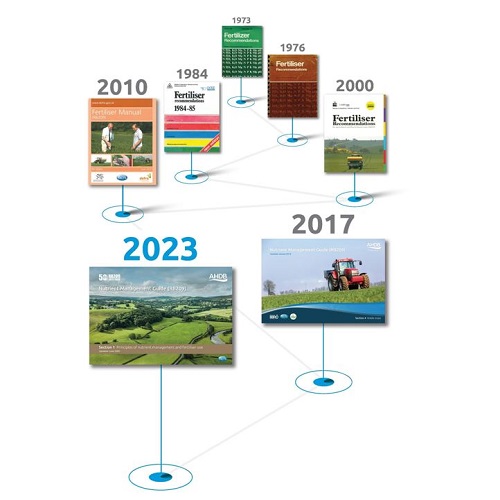A golden year for nutrient management
Thursday, 22 June 2023
Jason Pole reflects on 50 years of the Nutrient Management Guide (RB209).
RB209 and the early years
In 1973, Reference Bulletin 209 hit the shelves. It was the first comprehensive set of fertiliser recommendations for the UK’s major crops and the dawn of a new era.
The initial ‘Fertilizer Recommendations’ (with a ‘z’) were developed by the Ministry of Agriculture, Fisheries and Food (MAFF). Thankfully, the authors did not need to start from scratch. Nutrient management research had been conducted for well over a century. The ongoing Rothamsted Research ‘Broadbalk’ wheat nutrient experiment provides a well-known example (which started in 1843).
Previous nutrient management bulletins had been issued too, with the earliest – ‘Artificial fertilisers in modern agriculture’ (RB28) – published in 1931. Interestingly, ‘Manures and manuring’ was not allocated a bulletin number until its seventh edition in 1937 (RB36).
In the immediate post-war era, guidance focused on the recommended use of manufactured fertilisers. At that time, maximising output was a priority.
The first few editions of RB209 in the 1970s reflected the emphasis on artificial sources of nutrients. For example, organic manure information was relegated to a few lines of text and one small table.
During the MAFF and Defra eras, the environment was increasingly at the heart of the recommendations. Keen to reduce diffuse and point sources of pollution, the guidance emphasised the precise use of nitrogen. The final government-led (8th) edition of RB209 was published in 2010.
RB209 and the AHDB era
AHDB announced it would pick up the mantle in 2015. It formed the UK Partnership for Crop Nutrient Management and tasked UK experts to comprehensively review the guidance. Crop productivity took centre stage. Farmers, agronomists, breeders, researchers and fertiliser companies all fed into its review.
In 2017, AHDB launched its inaugral RB209 edition. Headlining the changes were yield adjustments for nitrogen (for wheat and barley). This allowed an increase or decrease (relative to reference yields) in nitrogen rates based on expected cereal yields. By accounting for past performance and the influence of the current season on potential yields, the strategy unlocked new nutrient management flexibility.
Most notably, the 2019 edition updated sulphur recommendations, which had remained largely fixed since the mid-90s. With atmospheric deposition decreasing and yield potential of modern varieties increasing, it was assumed that a sulphur boost was long overdue. However, experiments in winter oilseed rape revealed that only a modest increase was needed. The research also discovered that crops used sulphur from organic sources more efficiently than previously thought.
The most significant revisions to phosphorus management guidance since the 1980s occurred in the 2020 revision, with improvements to soil analyses, target indices and grain oftake values.
In 2021, RB209 entered uncharted territory. An energy crisis triggered unprecedentedly high fertiliser prices that worsened with war in Ukraine. It produced new ‘economic optima’ (break-even-ratios) – the point at which the value of extra grain produced is not worth the cost of the extra nitrogen applied.
To help farmers adjust rates in the 2021–22 season, AHDB invested in reactive work and swiftly issued updated guidance and released the nitrogen fertiliser adjustment calculator for cereals and oilseeds.
Spring barley was in the spotlight in 2022, with recommendations revised following an analysis of 15 years of trial data. It led to a boost to the crop’s expected yield benchmark (from 5.5 t/ha to 7 t/ha) and new yield-adjustment guidance.
Despite centuries of investment in research, the nitrogen management puzzle is far from being solved. The hazy – but influential – ‘farm factor’ means RB209 guidance and field-level experience always need to go hand in hand.
Milling wheat is a particularly fickle crop, as protein specifications add a further layer of complexity. The 2023 edition features improved guidance. It states that an extra 40 kg N/ha could increase grain protein by up to 0.5%, with a late foliar urea application during the milky ripe stage (GS73) generally better at increasing grain protein than the soil-applied stage. The edition also includes points to consider before committing to a milling wheat strategy.
The first AHDB edition included more robust nitrogen rate recommendations for modern winter oat varieties. In 2023, the guidance for both winter and spring oats was improved. For example, RB209 now supports yield adjustment for nitrogen in both crops and features better information on managing oat quality.
Over the last 50 years, RB209 has adapted to changes to crop production and the environment. The good news is that the current AHDB Cereals & Oilseeds sector plan pledges to keep RB209 up to date. This secures its future until at least 2027. I wonder what it will look like in 2073!
 AHDB
AHDB
Podcast: 50 years of RB209
The golden anniversary edition
In 1973, a hard copy of RB209 would have set you back 68 pence. In 2023, the 50-year anniversary edition is free to download and to order via ahdb.org.uk/rb209
Nutrient management research
To change RB209 guidance, robust evidence is required. It is why AHDB supports investment in nutrient management research. Here are a some of the more recent project that influenced AHDB-led revisions to RB209 (emphasis on section 4).


